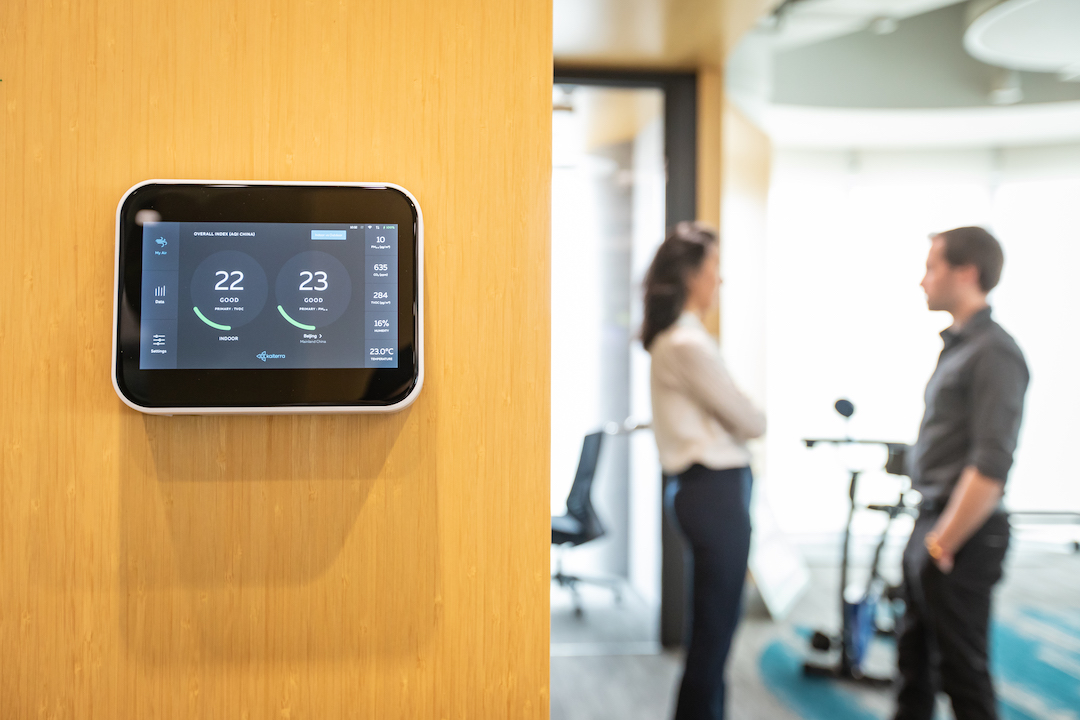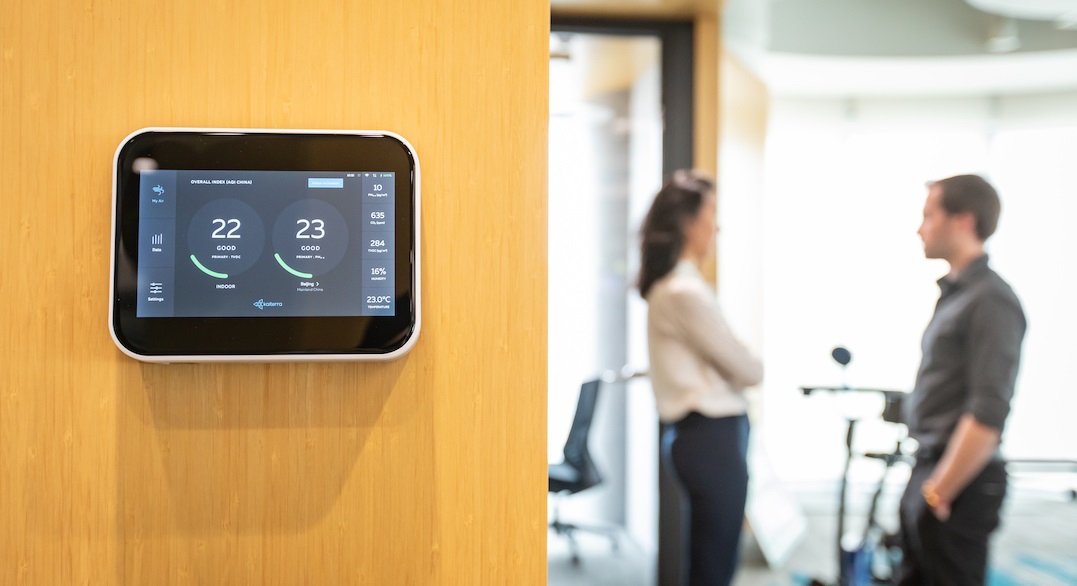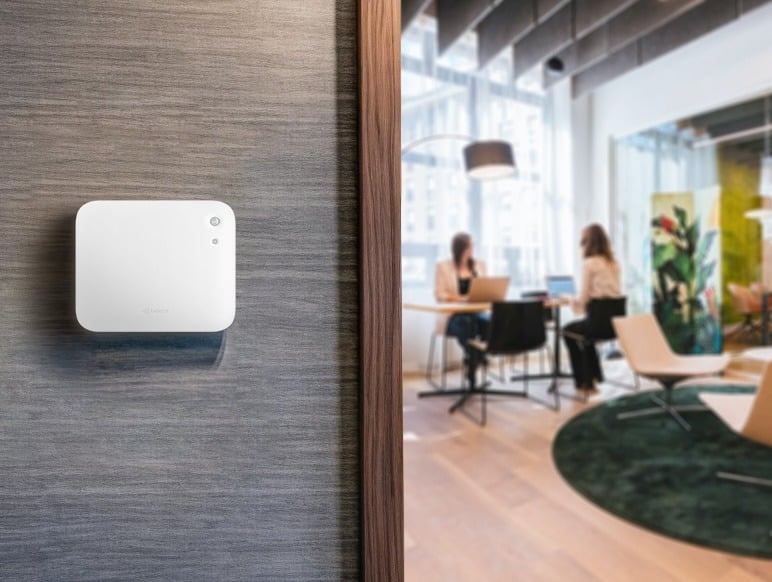Newsletter
Indoor air quality is one of the most important factors for businesses, with a majority of the workforce still very concerned about the quality of the air that they breathe during their workday.
On the consumer side, a study performed by Carbon Lighthouse shows that over 90% of U.S. consumers feel that indoor air quality is important in the prevention of COVID-19. On the employer side, the same study found that 74% of the surveyed office employees feel more comfortable returning to the office with IAQ information.
If you're exploring ways to enhance your workplace experience through improved indoor air quality, you'll want to read our FREE comprehensive guide on IAQ for healthy workplaces. Learn how IAQ data can be leveraged to elevate workplace performance, alleviate employee concerns, and drive better business outcomes.
How should you gather IAQ information? Air testing is an option, spot checks don't provide up-to-date air quality information on a building and repeated testing can be costly. The solution? Continuous air quality monitoring.

We’ve created a guide that covers the different types of air quality monitoring, the benefits of indoor air quality monitoring specifically, and some pointers to keep in mind when implementing air quality monitoring.
2023's Indoor Air Quality Monitoring Guide
1. Why should you invest in indoor air quality monitoring?
2. Types of indoor air quality monitoring
3. Key air quality parameters to measure
Why Should You Invest in Indoor Air Quality Monitoring?
There are many reasons why indoor air quality monitoring is a smart choice involving cost savings, real estate value, occupant health, and more.
Boost occupant wellness
We spend over 90% of our days inside; indoor air quality naturally plays a crucial role in our health, whether at home or in the workplace.
The main reason the five parameters we described above are so crucial to monitor is because of their impacts on human health and cognition. For employers, poor indoor air quality can negatively impact your employees’ productivity and cognitive performance.
- Productivity - Indoor air pollution significantly reduces the cognitive abilities of building occupants, thus impacting employee productivity. Particulate matter alone can reduce productivity by 5% to 6%, and a 500 μg/m³ increase in VOC concentration can reduce cognitive scores by 13%.
- Absenteeism - Poor indoor air quality is one of the most significant contributing factors for sick building syndrome, which can increase absenteeism in the workplace.
- Employee retainment - Research shows that improvements in air quality increase employee satisfaction in their workplace’s environmental conditions by 1.62 points on a 7 point scale, contributing to a boost in overall job satisfaction.
- Decision-making - As one facet of cognition, the decision-making capacity of employees are negatively impacted by indoor air pollution. In fact, a study by researchers from Columbia University discovered that exposure to particulate matter makes people more risk averse and more apt to lose out on opportunities.
How can indoor air quality monitoring help? Keeping tabs on the exact air quality conditions inside of a building allows you to swiftly evaluate those conditions, helping you identify areas that need improvement and keep track of your progress. Additionally, sharing your air quality data with building occupants can help establish trust and augment positive perceptions about the indoor environmental quality of the building.
Reduce building operating costs
Beyond health concerns, indoor air quality monitoring can reduce the costs of running a building through building automation and condition-based maintenance.
Demand-controlled ventilation is one well-known example of air quality monitoring integrating into the HVAC system. With this technology, ventilation rates vary based on carbon dioxide concentrations, which directly correlate with occupancy. This way, when a space is not occupied, ventilation rates are minimized to save energy.

Data collected from air quality sensors can also identify areas for maintenance. For example, if particulate matter readings on one floor are significantly worse than the rest of the building, that lets you know that the HVAC system needs repairs in that area or the filters need replacing. This principle was tested in four Microsoft buildings in China, where particulate matter sensors helped reduce energy consumption.
Earn building certifications
Lastly, air quality monitoring is a common factor in both healthy and green building certifications. Building standards and certification programs act as quality assurance to prospective tenants, raising the amount they are willing to pay and ensuring that occupants and employees are unhindered by poor indoor conditions.
One such program is WELL, a healthy building standard with a significant air quality component. Implementing continuous air quality monitoring for your project can help you earn points toward certification.

IWBI utilized the Sensedge in its NYC headquarters to receive a WELL certification.
Other building certifications, including RESET Air and LEED, also have air quality monitoring components that are either required or can help you secure additional points.
Types of Indoor Air Quality Monitoring
Let’s first provide a quick run-down of two ways to measure air quality: air quality testing and continuous monitoring.
With air quality testing, a sample of indoor air is collected then sent to a lab where it is analyzed for a particular pollutant. Air quality testing may seem like a more affordable option at first, but you will likely need to submit individual tests for each pollutant and may need to get your air retested to meet building codes or building standard requirements.

Continuous monitoring can provide real-time air quality data you can use for building certification and automation.
Continuous monitoring, on the other hand, collects samples at regular intervals and provides readings on the spot. You can monitor multiple parameters at once, and continuous monitoring eliminates the need for retesting. Air quality monitors themselves can be split up into three broad categories:
- Reference-grade air quality monitors
- Commercial-grade air quality monitors
- Consumer-grade air quality monitors
For the purposes of this article, we are going to focus on commercial air quality monitors designed for interiors; outdoor and in-duct air quality monitors have their own benefits to consider.
Key Air Quality Parameters to Measure
While the specific parameters will vary project-to-project, some key parameters to keep in mind are listed below:
- Particulate matter - With severe health consequences, particulate matter is both an outdoor and indoor air pollutant that can harm the physical health of building occupants and hinder productivity.
- TVOC - Volatile organic compounds (VOCs) can contribute to both short-term and long-term conditions, including sick building syndrome. Some VOCs also contain an odor, which may be unpleasant to building occupants and negatively impact perceptions about a space.
- Carbon dioxide - Elevated levels of carbon dioxide can cause fatigue, drowsiness, and headaches, as well as giving building occupants a general feeling of stuffiness.
- Temperature & relative humidity - Grouped together as thermal comfort, temperature and relative humidity are key for the comfort of building occupants.
All five of the above parameters have numerous impacts on health, and monitoring them will ensure that building occupant health and comfort are optimized.
How To Choose an Air Quality Monitor
How do you choose the best monitor for your project? In addition to monitoring parameters, there are some other factors to consider before investing in an indoor air quality monitor.
- Building certification requirements - Individual building standards have their own requirements for air quality monitoring that you need to be aware of before making your decision.
- Recalibration processes - Sensor recalibration is a necessary process that can be time consuming and costly. Some monitors, like the Sensedge and Sensedge Mini, have simple recalibration processes that can save you the hassle of traditional recalibration processes.
- Data collection, storage, and display - Before investing in an air quality monitoring system, you need to know how you want your data collected (for example, data output intervals), where you want your data stored, and how you want to display your data.
- Building automation - You should look for a monitor that can connect with your building automation to maximize the cost-saving benefits of continuous air quality monitoring.
4 Air Quality Monitoring Strategies To Remember
We’d like to sign off this compendious article by offering a few air quality monitoring tips, and help you avoid common indoor air quality mistakes. For those looking to invest in an air quality monitoring system, or those looking to optimize an existing system, we recommend following the four steps below:
- Take care of your air quality monitors - Like any piece of scientific equipment, air quality monitors need upkeep to maintain their accuracy and reliability. Make sure someone is responsible for ensuring that your devices are working properly, and that your sensors are calibrated or replaced as needed.
- Gather enough data - Not all spaces are the same; the parameters you choose to monitor and the number of devices you need depend on the project. Carefully evaluate your project to ensure that your readings reflect the true air quality of your space.
- Make the most of your air quality data - Now that you have the data you need, what should you do with it? To maximize the air quality monitoring benefits we described above, you should look to integrate air quality monitoring into your BAS to reduce building operating costs. You can learn more about this in our guide to office air quality.
- Share your data - Sharing your air quality data with building occupants can go a long way in boosting their confidence and building trust between building management and occupants, especially given the ongoing COVID-19 pandemic. You can share your data through a physical display, or through online options like the Kaiterra Dashboard.
Learn more about how indoor air quality data can be used to enhance the workplace experience, alleviate employee concerns, and drive better business outcomes in our FREE eBook, IAQ for Healthy Workplaces:






.png?width=200&height=148&name=Menu%20C%20(2).png)

.png?width=307&height=228&name=Menu%20-%20D%20(1).png)
.png)





